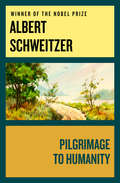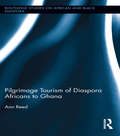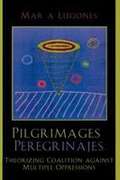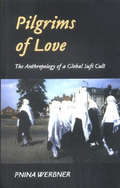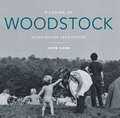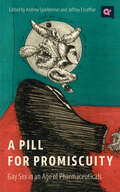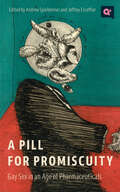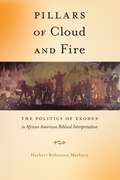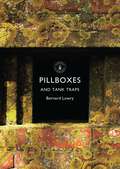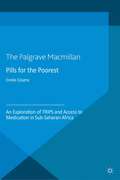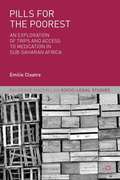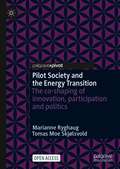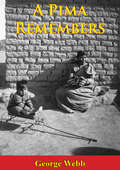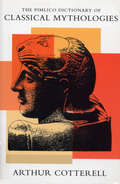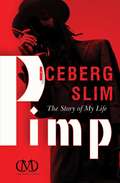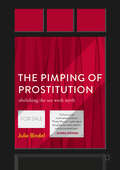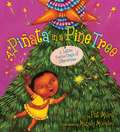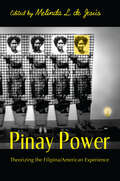- Table View
- List View
Pilgrimage to Humanity
by Albert SchweitzerThe dimensions of the central theme are illuminated by Schweitzer&’s discussions of his philosophy of culture, the course of his life, his ministry to human needs in Africa, the idea of reverence for life, the ideal of world peace, the significance of liberal Christianity, and the lives, world-views, and contributions of Johann Goethe, J. S. Bach, and Jesus of Nazareth. The pages of these selections give a remarkable revelation of the creative spirit of a modern saint and philosopher. The translation is by Water E. Stuermann, University of Tulsa.
Pilgrimage to Humanity: The Essence Of Faith, Pilgrimage To Humanity, The Quest Of The Historical Jesus, And The Light Within Us (Paperback Ser.)
by Albert SchweitzerThe dimensions of the central theme are illuminated by Schweitzer&’s discussions of his philosophy of culture, the course of his life, his ministry to human needs in Africa, the idea of reverence for life, the ideal of world peace, the significance of liberal Christianity, and the lives, world-views, and contributions of Johann Goethe, J. S. Bach, and Jesus of Nazareth. The pages of these selections give a remarkable revelation of the creative spirit of a modern saint and philosopher. The translation is by Water E. Stuermann, University of Tulsa.
Pilgrimage Tourism of Diaspora Africans to Ghana (Routledge Studies on African and Black Diaspora #6)
by Ann ReedProcesses of globalization have led to diasporic groups longing for their homelands. One such group includes descendants from African ancestors displaced by the trans-Atlantic slave trade, who may be uncertain about their families' exact origins. Traveling home often means visiting African sites associated with the slave trade, journeys full of expectations. The remembrance of the slave trade and pilgrimages to these heritage sites bear resemblance to other diasporic travels that center on trauma, identification, and redemption. Based on over two years of ethnographic fieldwork with both diaspora Africans and Ghanaians, this book explores why and how Ghana has been cast as a pilgrimage destination for people of African descent, especially African Americans. Grounding her research in Ghana’s Central Region where slavery heritage tourism and political ideas promoting incorporation into one African family are prominent, Reed also discusses the perspectives of ordinary Ghanaians, tourism stakeholders, and diasporan "repatriates." Providing ethnographic insight into the transnational networks of people and ideas entangled in Ghana’s pilgrimage tourism, this book also contributes to better understanding the broader global phenomenon of diasporic travel to homeland centers.
Pilgrimages and Spiritual Quests in Japan (Japan Anthropology Workshop Series)
by Dolores P. Martinez Maria Rodríguez del Alisal Peter AckermannThis exciting new book is a detailed examination of pilgrimages in Japan, including the meanings of travel, transformation, and the discovery of identity through encounters with the sacred, in a variety of interesting dimensions in both historical and contemporary Japanese culture, linked by the unifying theme of a spiritual quest. Several fascinating new approaches to traditional forms of pilgrimage are put forward by a wide range of specialists in anthropology, religion and cultural studies, who set Japanese pilgrimage in a wider comparative perspective. They apply models of pilgrimage to quests for vocational fulfilment, examining cases as diverse as the civil service, painting and poetry, and present ethnographies of contemporary reconstructions of old spiritual quests, as conflicting (and sometimes global) demands impinge on the time and space of would-be pilgrims.
Pilgrimages/Peregrinajes: Theorizing Coalition Against Multiple Oppressions (Feminist Constructions Series)
by María LugonesThe author has collected some of her most famous essays, as well as some lesser-known gems, in this book. She writes from her own perspective as an inhabitant of a number of different 'worlds.' Born in Argentina but living for a number of years in the United States, she sees herself as neither quite a U.S. citizen, nor quite an Argentine. An activist against the oppression of Latino/a people by the dominant U.S. culture, she is also an academic participating in the privileges of that culture. A lesbian, she experiences homophobia in both Anglo and Latino world. A woman, she moves uneasily in the world of patriarchy. She writes out of multiple and conflicting subjectivities that shape her sense of who she is, resisting the demand for a unified self in light of her necessary ambiguities. The book explores the possibility of deep coalition with other women of color, based on 'multiple understandings of oppressions and resistances'―understandings whose logic she subjects to philosophical investigation.
Pilgrims and Pilgrimages as Peacemakers in Christianity, Judaism and Islam (Compostela International Studies in Pilgrimage History and Culture)
by Antón M. PazosPilgrimages can be analysed as acts of conflict - such as the Crusades - or also as platforms for relationship building and rapprochement between religions. With a set of contributions from leading experts in the field, this book explores the concept of pilgrimage in Christianity, Judaism and Islam. Some specific examples of pilgrimages that helped to strengthen links between different religions or civilisations are explored, ranging from Europe to Asia and from the Middle Ages to the twentieth century. Even though every pilgrimage that is investigated here has helped to link different worlds, the case studies show that this relationship rarely led to a better in inter-understanding. Nowadays, peaceful coexistence seems to be its greatest achievement.
Pilgrims of Love: The Anthropology of a Global Sufi Cult
by Pnina Werbner"... will be of interest not only to those concerned with Pakistan and the new Muslim presence in Europe, but also to those interested in an anthropological study of religion." --Barbara Metcalf, University of California, DavisPnina Werbner traces the development of a Sufi Naqshbandi order founded by a living saint, Zindapir, whose cult originated in Pakistan and has extended globally to Britain, Europe, the Middle East, and southern Africa. Drawing on 12 years of fieldwork in Pakistan and Great Britain, she elucidates the complex organization of Sufi orders as regional and transnational cults, and examines how such cults are manifested through ritual action and embodied in sacred mythology and global diasporas. A focus of the study is the key event in the order's annual ritual cycle, a celebration in which tens of thousands of people gather at the saint's lodge in Pakistan and in the streets of Britain. Werbner challenges accepted anthropological and sociological truths about Islam and modernity, and reflects on her own role as ethnographic observer. Pilgrims of Love is a major contribution to our understanding of disaporic Islamic practices, highlighting the vitality of Sufi orders in the postcolonial world.
Pilgrims of Woodstock: Never-Before-Seen Photos
by John KaneIntimate portraits by photojournalist Richard F. Bellak of the musical festival&’s counterculture attendees celebrating peace, love, and rock and roll. In the summer of 1969, 400,000 people from across the country came together and redefined the music scene forever. Though the legacy and lore of Woodstock lives on in the memory of its attendees, a new generation can experience the real and unedited festival through Richard Bellak&’s never-before-seen photographs and John Kane&’s incredible new interviews.Pilgrims of Woodstock offers a vivid and intimate portrait of the overlooked stars of the festival: the everyday people who made Woodstock unforgettable. The photographs and interviews capture attendees&’ profound personal moments across hundreds of acres of farmland, as they meditated, played music, cooked food at night, and congregated around campfires. For three days, they helped and relied on each other in peace and harmony. For most, it was a life-changing event. Now, after the 50th anniversary of the famed festival, relive their experiences firsthand in Pilgrims of Woodstock.
A Pill for Promiscuity: Gay Sex in an Age of Pharmaceuticals (Q+ Public)
by Andrew Holleran Jeffrey Escoffier Kane Race Andrew R. Spieldenner Steve MacIsaac Daniel Felsenthal Nicolas Flores Alex Garner Deion Hawkins Pam Dore Addison Vawters Lore Tta LeMaster Ariel Sabillon Justice Jamal Jones Jeff WeinsteinFor a generation of gay men who came of age in the 1980s and 1990s, becoming sexually active meant confronting the dangers of catching and transmitting HIV. In the 21st century, however, the development of viral suppression treatments and preventative pills such as PrEP and nPEP has massively reduced the risk of acquiring HIV. Yet some of the stigma around gay male promiscuity and bareback sex has remained, inhibiting open dialogues about sexual desire, risk, and pleasure. A Pill for Promiscuity brings together academics, artists, and activists—from different generations, countries, ethnic backgrounds, and HIV statuses—to reflect on how gay sex has changed in a post-PrEP era. Some offer personal perspectives on the value of promiscuity and the sexual communities it fosters, while others critique unequal access to PrEP and the increased role Big Pharma now plays in gay life. With a diverse group of contributors that includes novelist Andrew Holleran, trans scholar Lore/tta LeMaster, cartoonist Steve MacIsaac, and pornographic film director Mister Pam, this book asks provocative questions about how we might reimagine queer sex and sexuality in the 21st century.
A Pill for Promiscuity: Gay Sex in an Age of Pharmaceuticals (Q+ Public)
by Andrew R. Spieldenner Jeffrey Escoffier Andrew Holleran Steve MacIsaac Daniel Felsenthal Kane Race Nicolas Flores Alex Garner Deion Hawkins Pam Dore Addison Vawters Lore Tta LeMaster Ariel Sabillon Justice Jamal Jones Jeff WeinsteinFor a generation of gay men who came of age in the 1980s and 1990s, becoming sexually active meant confronting the dangers of catching and transmitting HIV. In the 21st century, however, the development of viral suppression treatments and preventative pills such as PrEP and nPEP has massively reduced the risk of acquiring HIV. Yet some of the stigma around gay male promiscuity and bareback sex has remained, inhibiting open dialogues about sexual desire, risk, and pleasure. A Pill for Promiscuity brings together academics, artists, and activists—from different generations, countries, ethnic backgrounds, and HIV statuses—to reflect on how gay sex has changed in a post-PrEP era. Some offer personal perspectives on the value of promiscuity and the sexual communities it fosters, while others critique unequal access to PrEP and the increased role Big Pharma now plays in gay life. With a diverse group of contributors that includes novelist Andrew Holleran, trans scholar Lore/tta LeMaster, cartoonist Steve MacIsaac, and pornographic film director Mister Pam, this book asks provocative questions about how we might reimagine queer sex and sexuality in the 21st century.
Pillars of Cloud and Fire: The Politics of Exodus in African American Biblical Interpretation (Religion and Social Transformation #8)
by Herbert Robinson MarburyAt the birth of the United States, African Americans were excluded from the newly-formed Republic and its churches, which saw them as savage rather than citizen and as heathen rather than Christian. Denied civil access to the basic rights granted to others, African Americans have developed their own sacred traditions and their own civil discourses. As part of this effort, African American intellectuals offered interpretations of the Bible which were radically different and often fundamentally oppositional to those of many of their white counterparts. By imagining a freedom unconstrained, their work charted a broader and, perhaps, a more genuinely American identity. In Pillars of Cloud and Fire, Herbert Robinson Marbury offers a comprehensive survey of African American biblical interpretation. Each chapter in this compelling volume moves chronologically, from the antebellum period and the Civil War through to the Harlem Renaissance, the civil rights movement, the black power movement, and the Obama era, to offer a historical context for the interpretative activity of that time and to analyze its effect in transforming black social reality. For African American thinkers such as Absalom Jones, David Walker, Zora Neale Hurston, Frances E. W. Harper, Adam Clayton Powell, and Martin Luther King, Jr., the exodus story became the language-world through which freedom both in its sacred resonance and its civil formation found expression. This tradition, Marbury argues, has much to teach us in a world where fundamentalisms have become synonymous with “authentic” religious expression and American identity. For African American biblical interpreters, to be American and to be Christian was always to be open and oriented toward freedom.
Pillboxes and Tank Traps
by Bernard LowryThe very real threat of the invasion of Britain in 1940 initiated a huge military construction program. Around the vulnerable coasts of the country, as well as inland, were built thousands of pillboxes, anti-tank barriers and other obstacles to defeat or delay the invader. The end of WWII saw much cleared away but sufficient still remains, and this book guides the curious in identifying the remaining defensive structures and features which once formed part of the military landscape. Although, to our eyes, the survivals might seem randomly placed, there was always a considered plan and the book describes how these plans worked. Previously little appreciated, a national project (The Defence of Britain) has now identified many of the sites and there is a growing movement to protect what remains.
The Pillow Book of Sei Shonagon
by Ivan Morris Sei ShonagonMusings and observations of a Japanese lady-in-waiting at the Imperial Court at the end of the 9th century.
Pills for the Poorest: An Exploration of TRIPS and Access to Medication in Sub-Saharan Africa (Palgrave Socio-Legal Studies)
by E. CloatreThe desperate need for a vast part of the global population to access better medicines in more certain ways is one of the biggest concerns of the modern era. Pills for the Poorest offers a new perspective on the much-debated issue of the links between intellectual property and access to medication. Using ethnographic case studies in Djibouti and Ghana, and insights from actor-network theory, it explores the ways in which TRIPs and pharmaceutical patents are translated in the daily practices of those who purchase, distribute, and use (or fail to use) medicines in sub-Saharan Africa. It suggests that focusing on routine practices and the material deployment of intellectual property significantly enriches our understanding of the complex dynamics that animate the field of access to medicines and helps relocate the role of law within those processes. It demonstrates how intellectual property affects access to medicines in ways that are often discreet, indirect and forgotten. By exploring these complex mechanisms, it seeks to ask questions about the modes of actions of pharmaceutical patents, but also, more generally, about the complexity of legal objects.
Pills for the Poorest: An Exploration of TRIPS and Access to Medication in Sub-Saharan Africa (Palgrave Socio-Legal Studies)
by Emilie CloatreThe desperate need for a vast part of the global population to access better medicines in more certain ways is one of the biggest concerns of the modern era. Pills for the Poorest offers a new perspective on the much-debated issue of the links between intellectual property and access to medication. Using ethnographic case studies in Djibouti and Ghana, and insights from actor-network theory, it explores the ways in which TRIPs and pharmaceutical patents are translated in the daily practices of those who purchase, distribute, and use (or fail to use) medicines in sub-Saharan Africa. It suggests that focusing on routine practices and the material deployment of intellectual property significantly enriches our understanding of the complex dynamics that animate the field of access to medicines and helps relocate the role of law within those processes. It demonstrates how intellectual property affects access to medicines in ways that are often discreet, indirect and forgotten. By exploring these complex mechanisms, it seeks to ask questions about the modes of actions of pharmaceutical patents, but also, more generally, about the complexity of legal objects.
Pilot Society and the Energy Transition: The co-shaping of innovation, participation and politics
by Marianne Ryghaug Tomas Moe SkjølsvoldThis open access book examines the role of pilot and demonstration projects as crucial devices for conducting innovation in the context of the energy transition. Bridging literature from sustainability transitions and Science and Technology Studies (STS), it argues that such projects play a crucial role, not only in shaping future energy and mobility systems, but in transforming societies more broadly. Pilot projects constitute socio-technical configurations where imagined future realities are materialized. With this as a backdrop, the book explores pilot projects as political entities, focusing on questions of how they gain their legitimacy, which resources are mobilized in their production, and how they can serve as sites of public participation and the production of energy citizenship. The book argues that such projects too often have a narrow technology focus, and that this is a missed opportunity. The book concludes by critically discussing the potential roles of research and innovation policy in transforming how such projects are configured and conducted.
A Pima Remembers
by George WebbThe lifestyle of a people, preserved in the memory of a Pima whose life ran from the late 1800s to the Space Age. The universality of man’s eternal hope of betterment is reflected in the wisdom of the Pimas:So now I hopeYou will striveTo make this dayThe best in your life.George Webb. “…a book which seems to have grown right out of the Arizona earth—anecdotal, almost artless in its directness, but having the impact of reality…a flavorsome re-creation of things past in the life of a friendly, generous people.”— The New York Times“George Webb’s gentle recollections of his childhood and Pima Indian lifeways will doubtless endure forever. This deeply moving autobiography is the perfect introduction for younger Pimas to their culture and history.” —Arizona Highways“This extraordinarily pleasant and amiable narrative wakes vivid an ancient and happy way of life”—Oliver LaFarge
The Pimlico Dictionary Of Classical Mythologies
by Arthur CotterallThe Pimlico Dictionary of Classical Mythologies is a unique work of reference which breaks new ground by treating for the first time the classical mythologies of the Old World as a whole. Never before have the mythologies of Greece, Rome, Persia, India and China been encompassed in a single volume, despite the fact that the first four have much in common through their Indo-European ancestry. Arthur Cotterell shows how much more can be understood about 'classical mythology' by comparison and contrast of its five major traditions. Another key aspect of The Pimlico Dictionary of Classical Mythologies is that the myths are not simply recounted; their least accessible features are helpfully interpreted by reference to the culture in which they arose. Thus, for example, the profound influence of the Iranian prophet Zoroaster's thinking on Persian mythology is made clear, along with the far-reaching consequences its adoption would later have for Christian thought.The Pimlico Dictionary of Classical Mythologies also includes over two hundred original illustrations, which have been specially commissioned in order to reveal how gods and goddesses, heroes and heroines, sages, villains and demons were actually envisaged during the classical period. Taken together with the well-devised entries and the informative introduction, these unusual illustrations make The Pimlico Dictionary of Classical Mythologies an indispensable handbook for both students and the general reader.
Pimp: The Story of My Life (Sapphire Presents Ser.)
by Iceberg SlimBefore Hip Hop, there was the pimp. The book that brought black literature to the streets is back to show the Hip Hop generation what it's all about, where they came from. By telling the story of one man's struggles and triumphs in an underground world, this book shows the game doesn't change - it just has a different swagger. Iceberg Slim's story is now depicted in a major motion picture distributed worldwide. Iceberg Slim: Portrait of a Pimp shows Slim's transformation from pimp to the author of 7 classic books.As real as you can get without jumping in, this is the story of Slim's life as he saw, felt, tasted, and smelled it. Only he could tell this story and make the reader feel it. If you thought Hustle & Flow was the true pimp story, this book is where it all began. This is the heyday of the pimp, the hard-won pride and glory, small though it may be; the beginnings of pimp before it was dragged in front of the camera, before pimp juice and pimp style. A trip through hell by one man who lived to tell the tale. The dangers of jail, addiction and death that are still all too familiar for today's black community. Though it is a tale of his times, it will remain current and true for as long as there is a race bias, as long as there is a street life, as long as there is exploitation.
Pimpin' Ain't Easy: Selling Black Entertainment Television
by Beretta E. Smith-ShomadeLaunched in 1980, cable network Black Entertainment Television (BET) has helped make blackness visible and profitable at levels never seen prior in the TV industry. In 2000, BET was sold by founder Robert L. Johnson, a former cable lobbyist, to media giant Viacom for 2.33 billion dollars. This book explores the legacy of BET: what the network has provided to the larger US television economy, and, more specifically, to its target African-American demographic. The book examines whether the company has fulfilled its stated goals and implied obligation to African-American communities. Has it changed the way African-Americans see themselves and the way others see them? Does the financial success of the network - secured in large part via the proliferation of images deemed offensive and problematic by many black communities - come at the expense of its African-American audience? This book fills a major gap in black television scholarship and should find a sizeable audience in both media studies and African-American studies.
The Pimping of Prostitution: Abolishing the Sex Work Myth
by Julie BindelThis book examines one of the most contested issues facing feminists, human rights activists and governments around the globe – the international sex trade. For decades, the liberal left has been conflicted as to whether pro-prostitution activists or abolitionists hold the correct view, and debates are ongoing as to who holds the key to the solutions facing the women and girls involved.Over the course of two years, Bindel conducted 250 interviews in almost 40 countries, cities and states, traveling around Europe, Asia, North America, Australia, New Zealand, and East and South Africa. Visiting legal brothels all around the world, Bindel got to know pimps, pornographers, survivors of the sex trade, and the women being sold by men classed as ‘business entrepreneurs’. Whilst meeting feminist abolitionists, pro-prostitution campaigners, police and government officials, and the men who drive the demand, Bindel uncovered the lies, mythology and criminal activity that shroud this global trade, and suggests here a way forward for the women seeking to abolish the oldest oppression. Informed by the lived human experience of those interviewed, this book will be of great interest to feminists, students, criminal justice advocates, criminologists and human rights activists.
Pin-Up Grrrls: Feminism, Sexuality, Popular Culture
by Maria Elena BuszekSubverting stereotypical images of women, a new generation of feminist artists is remaking the pin-up, much as Annie Sprinkle, Cindy Sherman, and others did in the 1970s and 1980s. As shocking as contemporary feminist pin-ups are intended to be, perhaps more surprising is that the pin-up has been appropriated by women for their own empowerment since its inception more than a century ago. Pin-Up Grrrls tells the history of the pin-up from its birth, revealing how its development is intimately connected to the history of feminism. Maria Elena Buszek documents the genre's 150-year history with more than 100 illustrations, many never before published. Beginning with the pin-up's origins in mid-nineteenth-century carte-de-visite photographs of burlesque performers, Buszek explores how female sex symbols, including Adah Isaacs Menken and Lydia Thompson, fought to exert control over their own images. Buszek analyzes the evolution of the pin-up through the advent of the New Woman, the suffrage movement, fanzine photographs of early film stars, the Varga Girl illustrations that appeared in Esquire during World War II, the early years of Playboy magazine, and the recent revival of the genre in appropriations by third-wave feminist artists. A fascinating combination of art history and cultural history, Pin-Up Grrrls is the story of how women have publicly defined and represented their sexuality since the 1860s.
A Piñata in a Pine Tree: A Latina Twelve Days of Christmas
by Pat Mora"The Twelve Days of Christmas" has been a beloved carol for centuries. In this joyful new version, the traditional gifts have been replaced by Latin-flavored offerings with a tinge of magic. A secret amiga delivers presents to a little girl, filling the pages with brightly colored piñatas, burritos bailando (dancing donkeys), lunitas cantando (singing moons), and more. There are things to find and count and words in Spanish on every page, with pronunciations provided right in the pictures, and a glossary and music at the end of the book.
Pinay Power: Peminist Critical Theory
by Melinda L. de JesúsThis volume brings together for the first time critical work by Pinays of different generations and varying political and personal perspectives to chart the history of the Filipina experience.
Pinball Wizards: Jackpots, Drains, and the Cult of the Silver Ball
by Adam RubenPinball's history is America's history, from gambling and war-themed machines to the arcade revolution and, ultimately, the decline of the need to leave your house. The strangest thing about pinball is that it persists, and not just as nostalgia. Pinball didn't just stick around—it grew and continues to evolve with the times. Somehow, in today's iPhone world, a three-hundred-pound monstrosity of wood and cables has survived to enjoy yet another renaissance. Pinball is more to humor writer Adam Ruben than a fascinating book topic—it's a lifelong obsession. Ruben played competitive pinball for years, rising as high as the 80th-ranked player in the world. Then he had children. Now, mired in 9,938th place—darn kids—Ruben tries to stage a comeback, visiting pinball museums, gaming conventions, pinball machine designers, and even pinball factories in his attempt to discover what makes the world's best players, the real wizards, so good. Along the way, Ruben examines the bigger story of pinball's invention, ascent, near defeat, resurgence, near defeat again, and struggle to find its niche in modern society.
